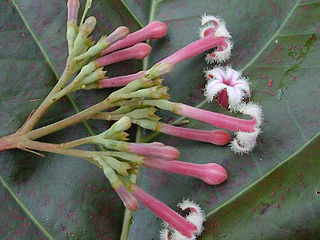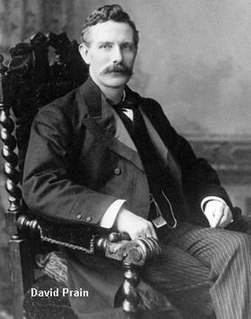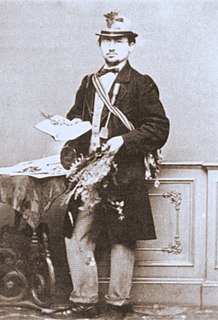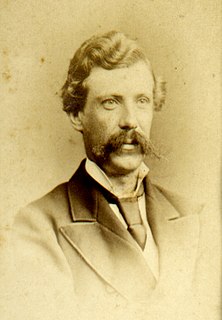James Alexander Gammie (12 November 1839 - 13 April 1924) was a Kew-trained Scottish gardener and botanist known for his work in raising cinchona plantations in Mungpoo in northeastern India and in introducing a process for the extraction of cinchona alkaloids at the factory in Rungbee. [1]

Royal Botanic Gardens, Kew is a non-departmental public body in the United Kingdom sponsored by the Department for Environment, Food and Rural Affairs. An internationally important botanical research and education institution, it employs 1,100 staff. Its board of trustees is chaired by Marcus Agius, a former chairman of Barclays.

Cinchona is a genus of flowering plants in the family Rubiaceae containing at least 23 species of trees and shrubs. They are native to the tropical Andean forests of western South America. A few species are reportedly naturalized in Central America, Jamaica, French Polynesia, Sulawesi, Saint Helena in the South Atlantic, and São Tomé and Príncipe off the coast of tropical Africa. Several species were sought after for their medicinal value and cultivated in India and Java where they also formed hybrids. The barks of several species yield quinine and other alkaloids that were the only effective treatments against malaria during the height of colonialism which made them of great economic and political importance. The synthesis of quinine in 1944, an increase in resistant forms of malaria, and alternate therapies ended the large-scale economic interest in their cultivation. Academic interest continues as cinchona alkaloids show promise in treating falciparum malaria which has evolved resistance to synthetic drugs.
Mungpoo is a town in West Bengal, Darjeeling district, India, located 33 km east of Darjeeling and 52 km north-east of Siliguri.
Gammie was born in Kincardine to George Gammie and Jean Silver. Gammie apprenticed at Drum Castle, Aberdeenshire, where his father was gardener for 45 years. He worked at Stapleton Park and with J. Veitch in Chelsea. He joined Kew in 1861 along with W.B. Hemsley and J.R. Jackson working for about four years until he was selected by the Secretary of State for India in August 1865 to manage the cinchona plantations in Sikkim. He moved to India and worked for eleven years retiring in 1897. An achievement was in the introduction of C.H. Wood's process for extracting the cinchona alkaloid using a solvent, fusel alcohol, from which the alkaloids were precipitated as sulphates using sulphuric acid. [2] [3] He was elected president of the Kew Guild in 1918. [4]
Kincardine may refer to:

Drum Castle is a castle near Drumoak in Aberdeenshire, Scotland. For centuries it was the seat of the chief of Clan Irvine. The place-name Drum is derived from Gaelic druim, 'ridge'.

James Veitch was the second in a long line of horticulturists who established the renowned family business Veitch Nurseries.
He collected plants for Sir George King and the Calcutta Herbarium and also studied mammals, birds and reptiles for the Indian museum. He was a friend of H.J. Elwes (hosting him on occasion and organizing Lepcha guides for him [5] ) and took an interest in the local butterflies, moths and the beetles of Sikkim. [6] Gammie also collected and made observations on birds which he communicated to Allan Octavian Hume, who as Secretary of State also supported his work at the cinchona plantations. [7] The snake Lycodon gammiei was named after him.

Sir George King, was a British botanist who was appointed superintendent of the Royal Botanic Garden, Calcutta in 1871, and became the first Director of the Botanical Survey of India from 1890. He was recognised for his work in the cultivation of cinchona and for setting up a system for the inexpensive distribution of quinine throughout India through the postal system.

Henry John Elwes, FRS was a British botanist, entomologist, author, lepidopterist, collector and traveller who became renowned for collecting specimens of lilies during trips to the Himalaya and Korea. He was one of the first group of 60 people to receive the Victoria Medal of the Royal Horticultural Society in 1897. Author of Monograph of the Genus Lilium (1880), and The Trees of Great Britain & Ireland (1906–1913) with Augustine Henry, as well as numerous articles, he left a collection of 30,000 butterfly specimens to the Natural History Museum, including 11,370 specimens of Palaearctic butterflies.

The Lepcha are also called the Rongkup meaning the children of God and the Rong, Mútuncí Róngkup Rumkup, and Rongpa, are among the indigenous peoples of Sikkim, India and number between 30,000 and 50,000. Many Lepcha are also found in western and southwestern Bhutan, Tibet, Darjeeling, the Mechi Zone of eastern Nepal, and in the hills of West Bengal. The Lepcha people are composed of four main distinct communities: the Renjóngmú of Sikkim; the Dámsángmú of Kalimpong, Kurseong, and Mirik; the ʔilámmú of Ilam District, Nepal; and the Promú of Samtse and Chukha in southwestern Bhutan.
Gammie married Mary Parrell at St Mary's Parish Church, Ealing on 28 January 1864 and they had nine children, the oldest of whom, George Gammie, became a botanist.
George Alexander Gammie was a British botanist who worked in India. He worked on a variety of plant groups including those of economic interest such as cotton and contributed to the knowledge of plants used during famines in India.
He died at his home on 1 Harvard road, Chiswick and was buried at Old Chiswick Cemetery on April 17, 1924. The funeral was attended by David Prain and a number of his old colleagues. [6] The value of his estate at the time of death was £5206 7s and his net personal property was £3972 8s. [8]

Sir David Prain was a Scottish physician remembered as a noted amateur botanist. He worked for many years in India working in the Calcutta Botanical Garden and involved in cinchona cultivation in Darjeeling.









